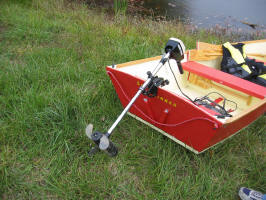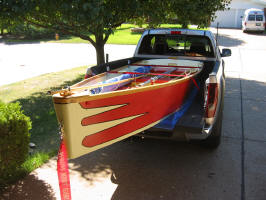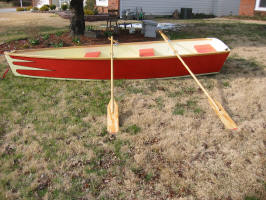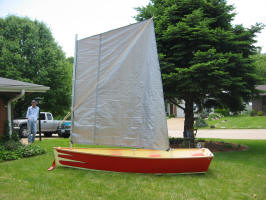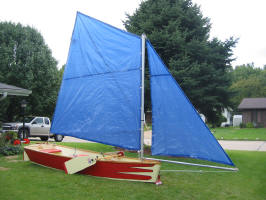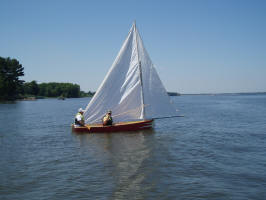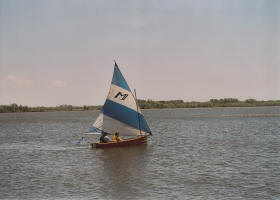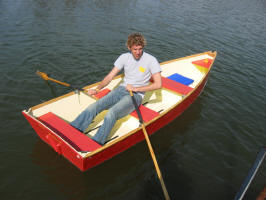|
The bottom sheet wasn't
of preferred quality (hidden voids) and hole rotted through at the
beginning of the 3rd season. The damaged area (2"x6") was easily cut out
and replaced. The plywood dagger board swelled and stuck in the slot
after a year so it was replaced with one polyurethane instead of latex
painted. This gives better waterproofing.
This boat is stored in an attached garage in St. Louis. Seasonal
temperature changes do have an adverse effect on it. No fasteners where
used in the construction. All joints were glued with water soluble glue
and fiberglass taped to waterproof them. A yearly fresh coat of paint on
the boat once year would be a good idea. Plus it makes the boat look
better and gives the builder a chance to have a different colored boat
each season! And it keeps the neighbors guessing.
I've broken a lot of rudders and mounts but now attribute that to rudders
that were too big and plywood rudder mounts that were inadequate. If a
rudder breaks too far to row home now, an oarlock is moved to one of the
plastic oarlock bushings installed in the aft corners braces, allowing an
oar to be used as an emergency rudder. This simple feature was designed
out by necessity and experience.
To make more room in the boat for sailing, I removed the third seat
between crew members , leaving just the thwart. The boat is best sailed
sitting on the floor to increase stability and allow headroom for jibing
booms . I applied doorstop to the top of the thwart matching the gunwale
rub-rails. This opened up 5 inches in each compartment. A temporary row
seat was made that straddles the top of the thwart to row out. It folds
into comfortable seat back while sailing.
The is a very fun and stable boat. It is easy to store and transport. It
can be a fun project for an entire family to do as a project. I liked the
economy of materials - very little scrap plywood was left over for the
fireplace. It is simple to construct and offers many opportunities for
modifications. I just wish I would remember to install integral cup
holders. It only takes about 10 minutes to put it in the water, drop the
rudder in, bang the dagger board down, haul the sail up, and go exploring.
"And while others wave to me from shore,
I battle real & imaginary sea serpents,
While rowing my guts out,
Or sailing my heart out.
Trying to go nowhere in particular
For no particular reason at all.
Other than the joy of being out on a lake,
On a nice warm sunny day.
In my own little boat,
That I made my own little self."
And there's nothing better them being
calmed in the middle of a vast lake knowing that you can't get to work
even if you wanted to.
Thanks, Uncle Johns!
Philip
St. Louis, MO |
